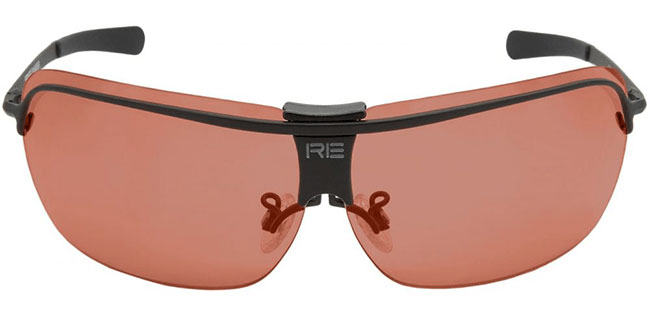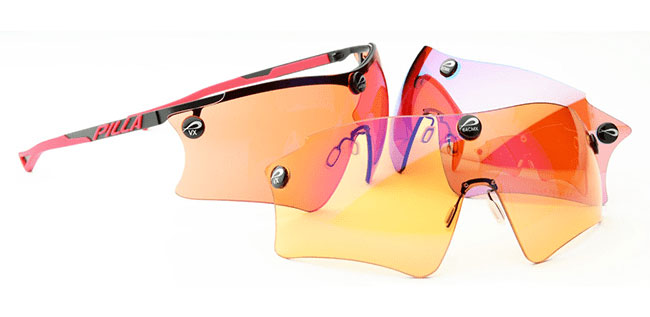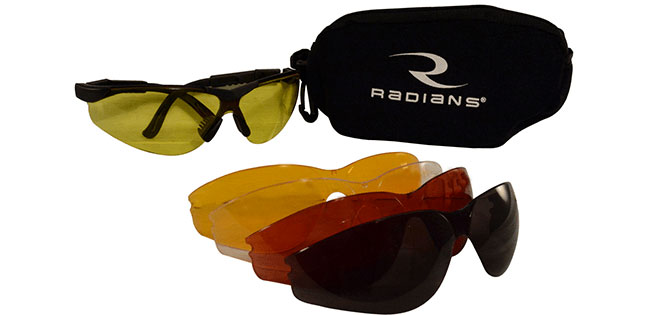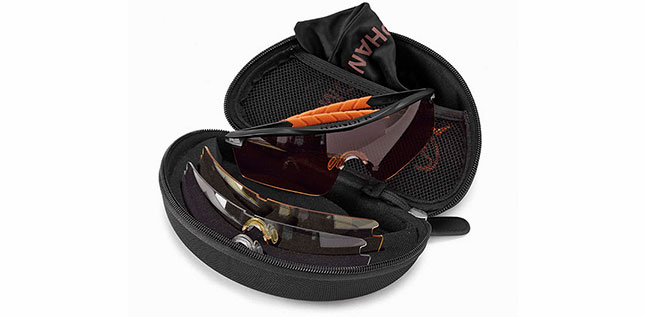Shooting Glasses for the Clay Sports—More Than Just Protection
By Bob Robb
Clay target shooters, like all shooters, require shooting glasses for eye protection. But did you know that choosing the right lens color based upon prevailing conditions can help you see the target better and improve your chances for success?
Clay Games Shooting Glasses 101
Specialized shooting glasses commonly have features designed to make you more comfortable while shooting. Frames usually have a “sweat bar” that runs the width of the frame above the lenses that adds stability to the frame and a more secure fit. Frames are also generally made in a roundish shape, to avoid sharp corners that could jab the face. There also might be some additional padding on the frame around the eyes. Spring hinges at the temples are often incorporated to allow the frame to flex during recoil, and adjustable nose pads allow for a perfect fit.
There are two strength standards of certification for shooting glasses, ANSI (American National Standards Institute) and military standards. ANSI requires the lenses must be able to stop a quarter-inch steel ball traveling at 150 feet per second (fps), which will protect the eyes from blowback debris. Glasses that meet this standard will have “Z87 certification” on the glasses or packaging. Military standards (MIL-PRF-31013) for shooting glasses are much more rigorous, requiring the lenses to stop a .15-inch-diameter steel ball traveling at 650 fps. They’re much stronger—and more expensive.
Shooting glass lenses are made from polycarbonate, the same material that bulletproof glass is made of. When impacted, polycarbonate will not shatter and create shards that can penetrate the eye. Polycarbonate lenses with a scratch-resistant coating and built-in ultraviolet (UV) protection have been the lenses of choice for shooting glasses for many years.
Glasses with a single fixed lens are the most common and least expensive choice. However, many companies offer glasses with interchangeable lenses so a shooter can match the lens color to prevailing conditions. Prescription lenses can be made to order in whatever color you want. Polarized lenses reduce glare caused by light reflecting off water and other flat surfaces, so outdoor vision is enhanced, and can also be made in almost any color. Photochromatic lenses darken automatically in response to sunlight and are available in a variety of colors. Whatever lens color you choose, consider having an anti-reflective (AR) coating applied to the back surface of the lenses. This eliminates potential glare from light reflecting off the back of your lenses when the sun is behind you.
Why Lens Color Is Important
What humans think of as daylight is actually composed of all the colors of the rainbow, but the individual colors cover only narrow portions of the visible light spectrum. Violet and blue are in the short wavelength part of the spectrum, green and yellow in the medium range, and orange and red are at the long end. When an object reflects all of these wavelengths equally, it appears white. Objects that absorb all visible wavelengths equally appear black. When an object absorbs the wavelengths in some bands and reflects others, it will have what we typically think of as a specific color. So, when looking at an orange clay target, the longer wavelengths in the orange-red part of the spectrum are reflected, while the rest of the wavelengths are nearly totally absorbed.
The primary way shooting glasses assist skeet, trap and sporting clays shooters see targets better is by filtering light through different colored lenses. Light conditions, backgrounds and target colors all come into play when it comes to how well and how fast you’ll pick up a target. Crafty sporting clays course designers know, for instance, that chartreuse targets flying against a background of nearly identically colored foliage ups the challenge level for shooters. Likewise with black rabbit targets rolled on dark ground coverings and white targets tossed across open skies. Changing your glasses to address each scenario can mean the difference between a hit and a miss.
Some manufacturers have taken tinting lenses to a custom level, offering more colors and grades of tint than one can imagine. However, there are nine basic lens colors. Here they are, and when they work best:
- Amber—Amber lenses block blue light and work best on low light or cloudy days. Amber creates contrast and allows targets to stand out even when conditions are not ideal.
- Blue—This color should be used only when shooting green targets. This is generally a custom option and a color that does not work well on bright sunny days regardless.
- Brown—Designed to boost the visibility of orange targets with vibrant color enhancement. It’s best used on bright, sunny days when shooting against an open, uncluttered background.
- Clear—Clear lenses work under a wide range of conditions, including shooting in low light and under the lights during night shooting events. They don’t distort colors.
- Gray/Green—These colors are often associated with standard sunglasses, and gray and green lenses do work well when shooting in bright sun. Gray lenses enhance contrast and depth in bright conditions extremely well, but they do not enhance orange targets.
- Orange—Helps block out blue light and haze and brings out the orange in standard clay targets. It’s an excellent all-around lens color for clay target shooting.
- Pink/Vermillion—This is an extremely popular choice with clay target shooters because they make orange targets really pop against a wide range of backgrounds, especially on bright, sunny days. Vermillion has become a favorite all-around lens color for many clay target shooters.
- Purple—Purple-tinted lenses are the No. 1 choice when shooting orange targets against a green background. Against green leafy cover, they enhance the orange target and emphasize the full depth of the background, helping you focus clearly on the target. It also reduces glare, even from snow.
- Yellow—This is an excellent choice for low-light conditions, including gray and overcast days and even in fog. Yellow lenses make white stand out brightly and enhance other target colors. The brighter yellow the lens color (there are various shades of yellow available), the better it is for use in low-contrast and near-dark conditions.
An Investment That Pays Off on the Scorecard
There are many reputable manufacturers of target sport eyewear to choose from, and pricing ranges from fairly inexpensive to anything but. As with many things, you often get what you pay for, but no matter what your budget is, try on as many as you can before buying, fitting them under your ear protection and in use with a ball cap if you regularly wear one to make sure they don’t fog up, slip, block your ability to see something crucial like your rib beads or fiber optics or interfere with your peripheral vision.
When it comes to choosing colors, many manufacturers package three or four colors together with the frame to sell as a set. They’re a good place to start, especially for skeet and trap shooters where the targets and backgrounds are more universal. For sporting clays and FITASC shooters, think about the courses you regularly shoot, their various backgrounds through the seasons and the target colors the ranges are known to throw. Those four-lens sets are a good place to start, but consider choosing a brand that has other lens choices you can add as needed to address specific conditions. Remember part of the point of having exchangeable lenses is to be able to quickly swap them out as the backgrounds and target colors change from station to station throughout a course.
All shooters must wear eye protection, so why not choose lens colors that can actually assist you in better seeing the target? Like your choke tubes and load choices, they’re just one more way to put “Xs” on the scorecard.




